So you have just begun your beard growth journey and started facing hurdles? Having red bumps under beard or beard rash is the most common beard problem most men face.
Red bumps under the beard or beard rash or folliculitis barbae is a condition where people have to go through the small, itchy, red, inflamed papulopustular eruption of hair follicles in the beard area.
These beard rash or cystic acne under beard may occur for various reasons. Ingrown hair, acne, and bacterial or fungal infections are some of them.
It is very crucial to diagnose it properly through a dermatologist or healthcare professional otherwise it may lead to a more severe condition.
Treating red bumps under beard requires a lot of patience, preventive measures, home remedies, and medical interventions.
One has to maintain good hygiene, use mild beard care products, and avoid excessive shaving and exfoliation. Also, the prescribed topical medications or oral antibiotics help relieve beard rash fast.
Table of Contents
What causes red bumps under the beard?
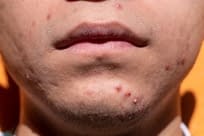
Beard rash or Folliculitis barbae most often happens due to bacterial infection caused by Staphylococcus aureus.
When a person shaves regularly, the hair gets cut at an angle, creating sharp edges that can pierce the skin upon regrowth.
These sharp edges allow bacteria to enter the hair follicles and cause infection, resulting in folliculitis barbae
As a result, we observe small, red, inflamed bumps around the hair follicles, itching, tenderness or pain in the affected areas, blisters, sores under the beard, swelling, and redness.
Folliculitis barbae can get annoyed by various factors, such as poor shaving techniques, using dull razors, inadequate hygiene, and naturally curly or coarse hair.
It is more common in individuals with oily skin and weak immune systems.
Red bumps under the beard can also occur by various factors, including:
- Ingrown Hairs: When beard hairs grow back into the skin instead of outward, they can cause inflammation and redness.
- Acne: The hair follicles in the beard area can become clogged with oil, dead skin cells, and bacteria, leading to the formation of pimples or acne-like bumps.
That is why proper diagnosis is crucial to know the reason behind the beard rash.
How to diagnose red bumps?
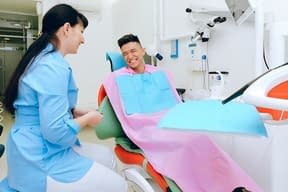
As we discussed, diagnosing the red bumps under the beard is too crucial because you may treat it wrongly if it happens due to other reasons like ingrown hair, acne, or beard care mistakes.
First of all, do not try to treat them by yourself. It is not a typical rash that can be treated with derma powders.
Consult your dermatologist or healthcare professional to determine the actual cause. Usually, dermoscopy helps to determine the skin, nails, and hair under magnification.
For severe conditions, the pustule and nasal cavity swabs help to identify bacterial culture and drug resistance and explore other possible causes.
7 Steps to treat red bumps under beard?
There is no single method to treat red bumps under the beard or beard rash. You have to combine home remedies, medicines, and preventive measures to wipe them off.
Here I have shared seven things you must consider while treating sores under your beard:
Maintain Good Hygiene:
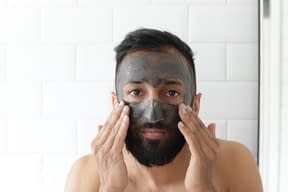
Good beard hygiene involves exfoliation, cleansing, and moisturizing the facial hair and the skin underneath.
If you have excess sores or bumps, avoid exfoliation for some time. Wash your beard area with mild beard soap or shampoo to prevent dirt, oil, and bacteria.
Always use beard shampoo or face wash free from harsh chemicals that can ruin your condition.
Use Suitable Beard Products:
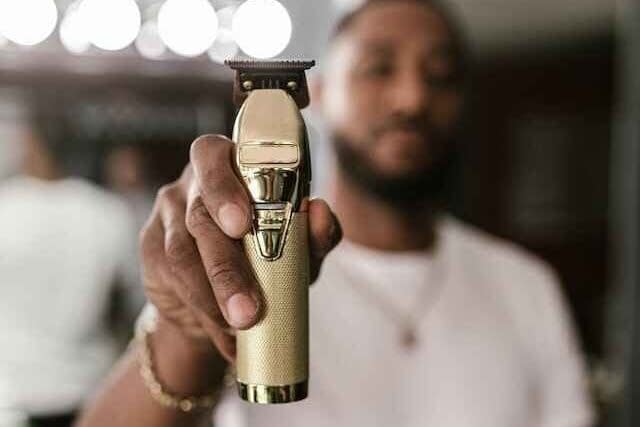
Choose beard oils for acne-prone skin or beard products specially made for sensitive skin types.
Beard care products like oil, balms, shampoos, and moisturizers must have mild ingredients free from harsh chemicals.
You can go with the beard balms made for african americans as they have more sensitive skin than any other.
Look for products with soothing ingredients like peppermint, aloe vera, or tea tree oil to help calm inflammation.
Avoid Excessive Shaving:
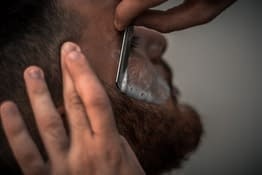
Limit excessive shaving or use the best trimmers for a close shave to get the same look, reducing the risk of ingrown hairs and irritation.
If you need to shave, use the best shaving cream for black skin as they have the most sensitive skin, clean, sharp razor, and follow the proper techniques.
Add Gentle Exfoliation:
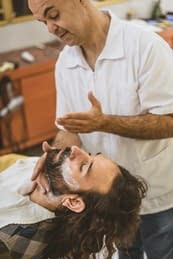
If your condition is getting worse, avoid exfoliation. But if your skin can beard it, use a soft bristle brush or mild exfoliating scrub for the beard to remove dead skin cells, excess oil, and clogged hair follicles.
Brushing your beard helps to remove dead skin cells, prevent clogged hair follicles and let them absorb the oil or serums we are putting in better.
Do not over-exfoliate, as it can cause further irritation.
Try Warm Compresses:
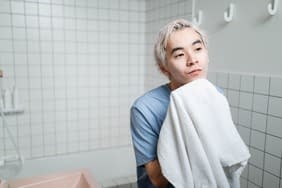
To reduce inflammation and promote healing, apply a warm, moist towel or cloth to the affected area.
Keep the compress in place for a few minutes and repeat this process multiple times throughout the day.
Home Remedies:

For treating red bumps under the beard, home remedies are one of the effective ways to deal with it in less time.
You can try tea tree oil, aloe vera gel, and more to reduce beard rash as soon as possible.
But remember to do a patch test before applying any of these remedies and ask for health care professional advice instantly if it affects you negatively.
Tea tree oil:
Using tea tree oil for a beard has many benefits, especially in relieving beard dandruff, beard rash, itching, or inflammation.
All you need is to dilute tea tree oil with carrier oil and apply it to the sores under the beard as a natural antibacterial and anti-inflammatory solution.
Aloe vera gel:
Apply pure aloe vera gel to the affected area. It has soothing and anti-inflammatory properties that can help reduce redness and irritation.
Witch Hazel:
Dab witch hazel onto the affected area using a cotton pad. Witch hazel possesses astringent properties that can assist in reducing inflammation and disinfecting the skin.
Apple Cider Vinegar:
Mix apple cider vinegar with water and apply it to the red bumps using a cotton pad. Apple cider vinegar contains antibacterial properties that may aid in combating infection and reducing inflammation.
Oatmeal Bath:
Soothe irritated skin by taking an oatmeal bath. Soak in a bath with colloidal oatmeal for 15-20 minutes. After bathing, pat your skin dry gently.
Honey:
Directly apply raw honey to the red bumps and leave it on for approximately 15 minutes before rinsing off.
Honey possesses antimicrobial and anti-inflammatory properties that can potentially alleviate symptoms.
Seek Medical Intervention:
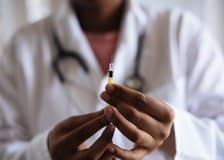
If the red bumps under your beard continue or worsen, or you experience severe pain, pus, or signs of spreading infection, consult a dermatologist or healthcare professional.
They can make an accurate diagnosis and recommend appropriate treatment choices.
Topical medications, including antibiotics, corticosteroids, or antifungal creams, may be prescribed by the healthcare professional to address the underlying cause of the red bumps.
Oral medications such as antibiotics or antifungal drugs can also help to treat beard rash.
Remember, the treatment approach may vary depending on the specific cause of the red bumps under your beard. Consulting a healthcare professional is crucial to receive a personalized treatment plan that addresses your needs and ensures an accurate diagnosis.
Post-treatment care for red bumps

After receiving treatment for red bumps under the beard, it is crucial to follow post-treatment care to promote healing and prevent future occurrences.
Here are some general post-treatment care guidelines:
Follow Good Hygiene:
Cleanse your beard with a mild cleanser or shampoo at least twice a day to keep bacteria, dirt, and oil buildup at bay.
Make sure to use chemical-free beard care products to minimize the adverse effect.
Abide by Dermatologist’s Instructions:
Adhere to the instructions provided by your dermatologist or healthcare professional regarding prescribed medications, such as topical creams or oral antibiotics.
Use the medications as directed and complete the entire course of treatment.
Take your follow-up appointments with your dermatologist seriously to monitor your progress and address any queries.
Avoid Touching or Picking:
Touching, squeezing, or picking the red bumps under the beard enhances irritation, inflammation, and infection.
Avoid touching your face, especially your beard rash to prevent the risk of scarring.
Moisturize properly:
Stick to a gentle, non-comedogenic moisturizer or lotion to keep the beard area hydrated and free from dryness.
Choose moisturizers specifically designed for sensitive or acne-prone skin that may have tea tree oil, aloe vera or other soothing ingredients .
Use sunscreen:
Excessive sun exposure can be a reason for skin irritation, pigmentation, dryness and brittleness of the beard area.
Never forget to use sunscreen with high SPF or to cover the entire face during a day.
Avoid excessive Shaving or Trimming Too Closely:
If possible, allow the beard to grow slightly to reduce the risk of ingrown hairs and further irritation.
If you need to shave, use a clean, sharp razor and follow proper shaving techniques to minimize irritation.
Maintain a Healthy Lifestyle:
Ensure you eat a balanced diet having full of fruits, vegetables, and nutrients to promote overall skin health.
Practice stress management techniques, do yoga and get adequate sleep to support skin healing.
Remember, individual post-treatment care of red bumps under the beard may vary depending on the specific treatment received and the advice given by your healthcare professional.
Conclusion:
Red bumps under the beard has become common while growing your beard or during beard care jouney.
Beard rash or follicullitis barbae appear as red, inflamed bumps around the hair follicle that are itchy, irritating, painfull and form pus inside themselves.
To treat red bumps, we have to combine home remedies, medicines, and preventive measures to prevent them from coming back.
FAQs:
What causes a red rash under a beard?
A red rash under a beard can occur due to ingrown hairs, folliculitis (hair follicle inflammation), acne, skin irritation from shaving or grooming, or an allergic reaction to beard products.
How do I get rid of bumps on my beard?
To get rid of bumps on your beard, maintain good hygiene, avoid excessive shaving, use suitable beard products, apply warm compresses to soothe the skin, and consider using natural remedies like tea tree oil or aloe vera. For severe cases, consult a dermatologist for personalized treatment and advice.
How long do beard bumps last?
The duration of beard bumps can vary depending on the underlying cause and how they are treated. Minor beard bumps may resolve within a few days to a week with proper care and hygiene. However, more severe or persistent beard bumps, such as those caused by folliculitis or ingrown hairs, may take several weeks to heal.
Does beard oil prevent bumps?
Beard oil can help prevent bumps by moisturizing the skin and hair, reducing dryness and irritation. Also, some beard oils contain soothing ingredients like tea tree oil, which may help prevent inflammation and reduce the risk of bumps. However, it may not completely eliminate beard bumps caused by other factors like ingrown hairs or folliculitis.
How do I prevent ingrown hair bumps on my beard?
To prevent ingrown hair bumps on your beard, use a clean, sharp razor, shave in the direction of hair growth, and avoid multiple passes over the same area. Exfoliate regularly to remove dead skin cells, keep the beard area clean, and consider growing a slightly longer beard to reduce the likelihood of ingrown hairs.
Kayden is an entrepreneur, writer, hairstylist working in a professional salon. He specializes in men’s grooming. He loves to blog about beards, hairstyles, and skincare.